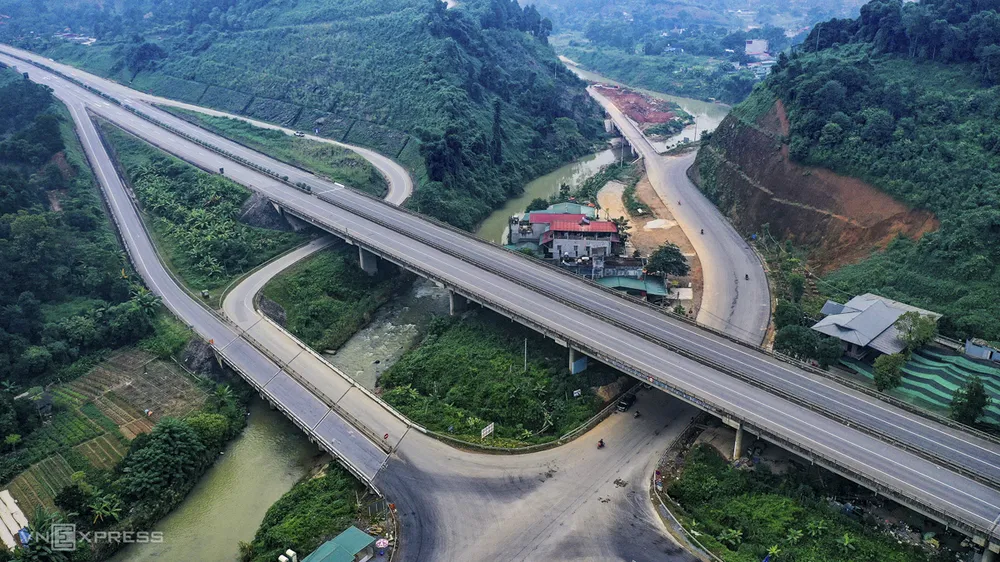
Since then, numerous rapid transportation routes have been initiated in various regions of Vietnam, particularly in the North, Central, and the rapidly expanding Eastern and Southwest regions. Notably, eight out of eleven component projects of the Eastern North-South Expressway were completed between 2017 and 2020, effectively increasing the total length of the country's highways to 1,822 kilometers. Furthermore, construction has commenced on twelve component projects of the East section of the North-South Expressway within the 2021-2025 timeframe. Additionally, expressway projects such as Khanh Hoa - Buon Ma Thuot, Bien Hoa - Vung Tau, Chau Doc - Can Tho - Soc Trang, Ho Chi Minh City's Belt 3, and Hanoi Capital Region's Belt 4 are in the pipeline.
Expressways have ushered in significant benefits by shrinking distances between provinces and cities, as the newly established routes offer more direct paths. In the past, technological limitations and challenging terrains, such as mountains, hills, soft soil, and wide rivers, necessitated detours. Today, technological advancements enable constructors to navigate mountains and span bridges of virtually unlimited length, resulting in shorter, higher-quality roads with more lanes. This enhancement facilitates vehicle speeds of 120-150 kilometers per hour, reducing travel time dramatically. For instance, the journey from Hanoi to Lao Cai now takes merely about 4 hours, while the route from Ho Chi Minh City to Phan Thiet can be covered in just over 2 hours.
However, a paradox emerges as we "pull the far closer"; we simultaneously "push the near further away." This dilemma becomes apparent in communities situated along these newly constructed highways. A prevalent issue along almost all inter-provincial highways is the tendency of people residing on both sides of the road to find ways to cross these high-speed thoroughfares. Residents often dismantle mesh fences, destroy iron railings, and cut horizontal protective bars, aiming to traverse the highway despite the high-speed traffic. Such arbitrary dismantling not only jeopardizes traffic safety but also infringes upon the law, as it involves the destruction of public property and creates insecurity in the area. A few instances illustrate this concerning trend.
Immediately after the Noi Bai - Lao Cai Expressway was inaugurated along its entire length, several households on either side of the road began dismantling fences and guardrails, allowing their cattle to graze and cultivating crops within the expressway corridor. Some even ventured onto the highway to catch buses, resulting in ten traffic accidents that claimed eleven lives and injured five individuals. Along the 51-kilometer-long Lo Te - Rach Soi highway, which passes through Can Tho city and Kien Giang province, numerous sections of fencing have been dismantled, posing a significant threat to both motorists and residents. Similar incidents have occurred on the Cam Lo - La Son Expressway, which spans Quang Tri and Thua Thien - Hue, covering a distance of 98.35 kilometers, with dozens of locations where people have tampered with the protective fence. The same situation persists on highways such as Ho Chi Minh City - Long Thanh - Dau Giay, Lien Khuong - Da Lat, and Hanoi - Bac Giang.
In response to this ongoing issue, project management boards have explored various technical solutions to prevent these actions. Such measures include elevating the roadbed to create a higher embankment, substituting deeply embedded concrete columns for iron columns, replacing railings with corrugated iron, adding more columns, and welding protective railings in place of bolting. Additionally, local authorities have issued warnings and imposed fines, but the problem persists, with the risk of accidents increasing rather than decreasing.
It is essential to acknowledge that design consultants and construction contractors may have inadvertently overlooked the needs of these affected communities. While overpasses have been constructed, they are often too sparse and disconnected from residential areas, rendering them difficult to use effectively. In many instances, overpasses are not integrated into the fabric of local neighborhoods, and this lack of accessibility hinders their utility. In the Western tradition, each end of an irrigation canal typically features a local road, allowing residents to easily travel, transport agricultural tools, and convey agricultural supplies to their homes for farming purposes. However, after the completion of the Lo Te - Rach Soi Expressway, the residential land was divided into two separate areas, and the construction of residential roads along the route was prohibited.
Building tunnels beneath the roadway may present a more expensive alternative to overpasses, but they could offer enhanced convenience for residents and vehicles while facilitating the movement of construction materials and bulky goods. Unfortunately, investors have shown little interest in underground tunnels due to their cost, complexity, and lengthier construction timelines. Consequently, there are scarce underground tunnels on Vietnam's highways. While highway development is undoubtedly crucial, it should not compel communities to sacrifice their collective interests. As Professor John Macionis of the University of Illinois once cautioned, one of the adverse consequences of routing highways through traditional villages is the disruption of these longstanding communities.
In conclusion, the rapid expansion of expressways in Vietnam is undoubtedly a testament to the nation's development and modernization. However, it is imperative that the interests and well-being of the communities these expressways traverse are given due consideration. Striking a balance between efficient transportation and the preservation of local communities is essential to ensuring that progress benefits all.




















